A Traveler’s Guide to the Mogao Caves: Art, History, and Adventure Await
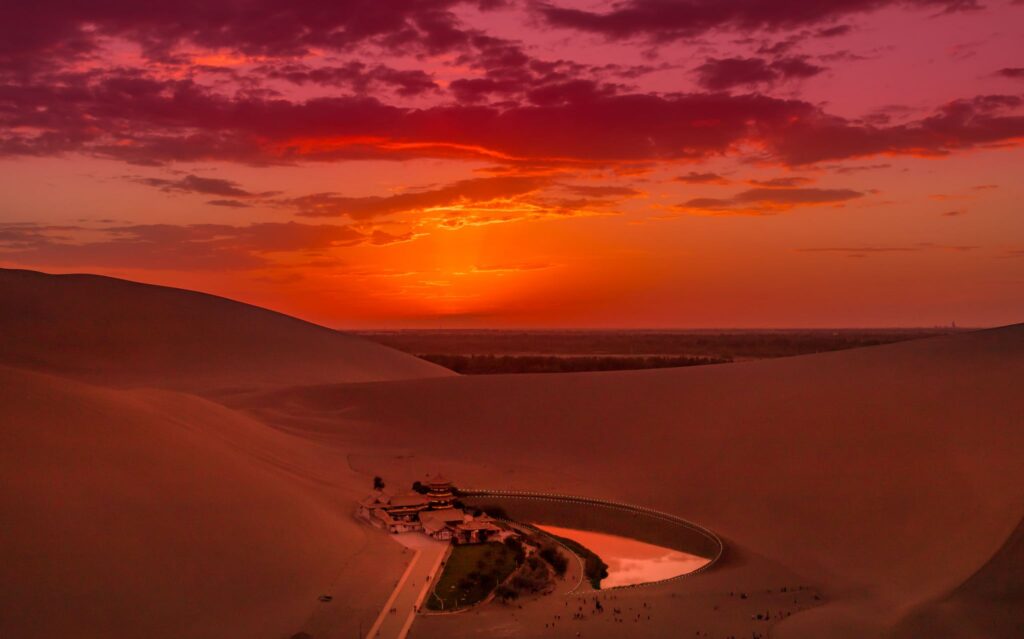
An Essential Guide to Visiting Mogao Caves
Nestled in the heart of the Gobi Desert, the Mogao Caves, also known as the Caves of the Thousand Buddhas, represent a breathtaking intersection of art, spirituality, and history. This UNESCO World Heritage Site, dating back to as early as the 4th century, boasts an astonishing collection of over 3,000 sculptures and exquisite wall frescoes that narrate the evolution of Buddhist art over a millennium. As you wander through these ancient caves, each adorned with vibrant colors and intricate designs, you’ll be transported back to a time when this site served as a crucial hub along the Silk Road, connecting diverse cultures and fostering the exchange of ideas.
Visiting the Mogao Caves is not just an exploration of art; it’s a journey into the very soul of Buddhism in China. With only a select number of caves open to the public, guided tours provide an intimate glimpse into the stories behind these masterpieces. Anticipate the thrill of stepping into a realm where every brushstroke tells a tale and where the serene ambiance invites reflection and contemplation. Whether you are an avid history buff, a lover of art, or simply in search of a unique adventure, the Mogao Caves promise an unforgettable experience that will linger in your memory long after you’ve left the desert sands behind.
In This Guide
- An Essential Guide to Visiting Mogao Caves
- The Rich History and Legends of Mogao Caves
- Main Highlights: What You Absolutely Can’t Miss
- Planning Your Visit: A Practical Guide
- Tickets: Prices, Booking, and Tips
- How to Get There: A Complete Transportation Guide
- Local Cuisine and Accommodation Nearby
- Frequently Asked Questions
- Final Thoughts on Your Trip
The Rich History and Legends of Mogao Caves
Nestled in the arid expanse of the Gobi Desert, the Mogao Caves, also known as the Caves of the Thousand Buddhas, stand as a monumental testament to the rich tapestry of Buddhist art and culture that flourished along the ancient Silk Road. Their inception dates back to the 4th century, during the Northern Liang Dynasty, when a Buddhist monk, motivated by a vision, began to carve out these caves as a sanctuary for meditation and artistic expression. Over the subsequent centuries, the site expanded dramatically, with construction continuing until the 14th century, resulting in an impressive complex of 492 caves.
The Mogao Caves are renowned for their exquisite frescoes and sculptural works, boasting over 3,000 statues and murals that depict Buddhist teachings, local legends, and the evolution of religious thought. The artistry within these caves reflects a blend of various cultural influences, as traders and pilgrims from different regions converged here, bringing with them their unique styles and beliefs. This cultural exchange is vividly illustrated in the intricate wall paintings that adorn the cave interiors, showcasing not just religious iconography but also scenes of daily life, celestial beings, and vibrant landscapes.
One of the most captivating legends associated with the caves is that of the “Caves of the Thousand Buddhas.” According to local lore, the monk who initiated the cave’s construction was guided by the divine light of a thousand Buddhas, which illuminated the path for him and his followers. This legend has imbued the site with a spiritual significance that continues to resonate with visitors from around the world.
Throughout the centuries, the Mogao Caves have not only served as a spiritual refuge but also as a center for learning and scholarship. The caves housed countless manuscripts, including the famous Dunhuang manuscripts, which provide invaluable insights into the history, religion, and culture of ancient China and beyond. The discovery of these texts in the early 20th century has helped historians piece together the remarkable story of the Silk Road and the role these caves played in facilitating cultural exchange.
With their designation as a UNESCO World Heritage Site in 1987, the Mogao Caves have garnered international recognition as one of the most significant repositories of Buddhist art and history. Today, efforts are ongoing to preserve and protect this treasured site from the ravages of time and climate. Visitors to the caves are not only treated to an awe-inspiring visual experience but also an evocative journey through the rich history and timeless legends that have shaped this remarkable cultural landmark.
As you wander through the intricate corridors of the Mogao Caves, take a moment to reflect on the myriad stories etched into the stone, each one a whisper from the past that invites you to explore the profound legacy of this extraordinary site.
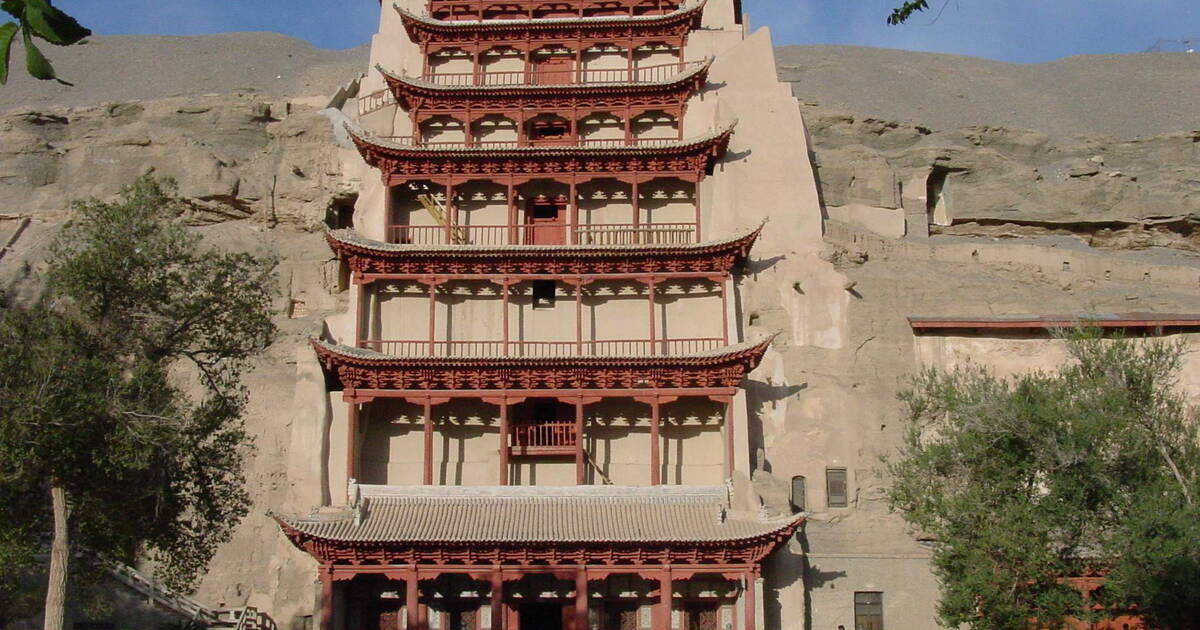
Mogao Caves.
Main Highlights: What You Absolutely Can’t Miss
The Mogao Caves, also known as the Caves of the Thousand Buddhas, are an extraordinary treasure trove of art and history nestled in the Gobi Desert, making them a must-visit for any international traveler. Spanning from the 4th to the 14th centuries, this UNESCO World Heritage site boasts an incredible collection of wall frescoes and over 3,000 sculptures, showcasing the evolution of Buddhist art over a millennium. Here are the main highlights that you absolutely cannot miss during your visit.
1. The Visitor Center and Digital Exhibition
Begin your journey at the impressive Digital Exhibition Center. Here, you can enjoy two high-quality films that provide an in-depth introduction to the history and significance of the caves. The immersive 360° presentation is particularly engaging, offering a visual feast that sets the stage for the wonders that await inside the caves.
2. Guided Tour of Selected Caves
Access to the caves is typically through guided tours, which are essential for gaining context about the artworks you’ll encounter. Guides are available in multiple languages, including English and Japanese, and will escort you to eight of the most significant caves. Each cave features unique frescoes and sculptures that reflect the rich tapestry of Buddhist culture and artistry.
3. Stunning Frescoes and Sculptures
As you explore the caves, take time to marvel at the intricate frescoes that adorn the walls, depicting scenes from Buddhist mythology, historical events, and daily life during the Tang and Song dynasties. Don’t miss the exquisite sculptures, including the iconic 34-meter tall statue of Maitreya Buddha in Cave 130, which captivates with its serene expression and elaborate details.
4. Cave 17: The Library Cave
If time permits, venture to Cave 17, famously known as the Library Cave. This cave was discovered in 1900 and contained thousands of ancient texts and artworks that date back to the early days of Buddhism in China. Although access may be limited, the historical significance of this cave makes it worth seeking out.
5. Photography and Souvenirs
While photography inside the caves is restricted to preserve the delicate artworks, there are numerous opportunities outside and at the visitor center. Be sure to check out the gift shop for unique souvenirs, including replicas of the cave art and books detailing the history of the Mogao Caves.
6. Stunning Desert Scenery
After your tour, take a moment to appreciate the breathtaking scenery of the Gobi Desert surrounding the caves. The stark beauty of the landscape contrasts sharply with the intricate art inside the caves, providing an unforgettable backdrop for your visit.
7. Tips for a Smooth Visit
- Plan Ahead: Book your tickets in advance through official channels to secure your spot and avoid long queues.
- Stay Hydrated: Bring water and snacks, as food options are limited within the cave complex.
- Dress Comfortably: Wear comfortable shoes and clothing suitable for walking and the varying temperatures of the desert environment.
In summary, the Mogao Caves offer an enchanting glimpse into the past, filled with artistic brilliance and historical significance. Whether you are an art enthusiast, a history buff, or simply seeking a unique travel experience, the caves promise an unforgettable adventure that will enrich your journey along the Silk Road.
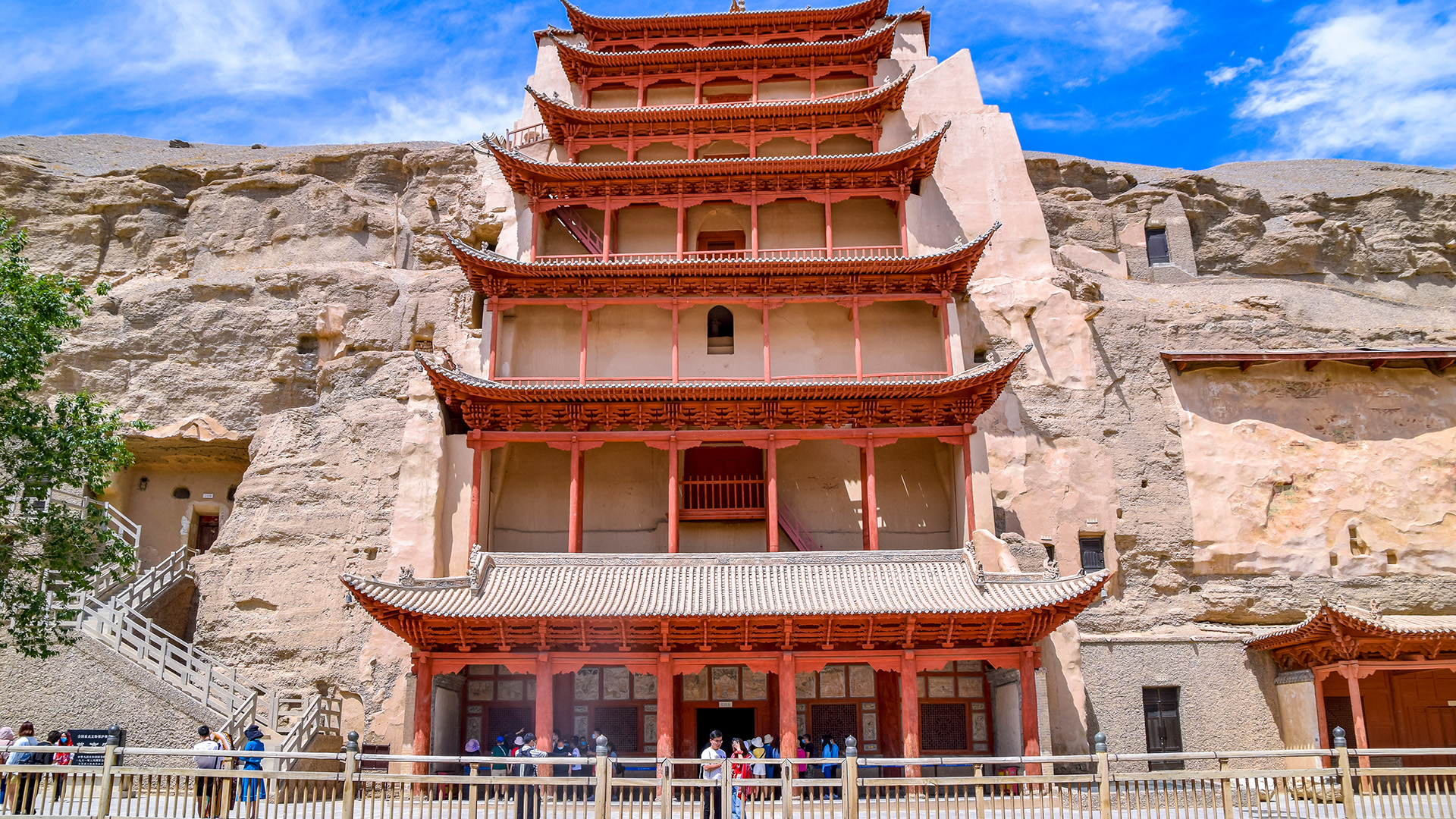
Mogao Caves.
Planning Your Visit: A Practical Guide
Visiting the Mogao Caves, a UNESCO World Heritage site nestled in the Gobi Desert near Dunhuang, is a journey into the heart of ancient Buddhist art and culture. With its stunning frescoes and thousands of sculptures, the caves offer a unique glimpse into the past. To ensure a fulfilling experience, here’s a guide to help you plan your visit.
Getting There
Location: The Mogao Caves are located approximately 25 kilometers southeast of Dunhuang city center.
Transportation:
– By Bus: Local buses run from Dunhuang to the Mogao Caves, providing an affordable option.
– Taxi or Rideshare: For convenience, consider taking a taxi or using a rideshare app.
– Tours: Many visitors opt for guided tours that include transport, which can enhance your experience with expert insights.
Opening Hours
Mogao Caves are open daily from 9:00 AM to 5:00 PM. It is advisable to arrive early to avoid crowds and enjoy a more leisurely exploration.
Admission Fees
The entrance fee for the Mogao Caves is approximately 250 yuan. This ticket typically includes access to a digital exhibition center and several guided tours of selected caves. It’s worth noting that tickets can sell out, especially during peak tourist seasons, so booking in advance is a smart move.
What to Expect
-
Visitor Center: Your journey begins at the Digital Exhibition Center, where you can watch informative films about the caves. This immersive experience will help you appreciate the cultural significance of the art you are about to see.
-
Guided Tours: Due to preservation efforts, only a limited number of caves are open for guided tours at any given time. Expect to visit around eight caves during your visit. Guides often speak multiple languages, including English and Japanese, so be sure to request language support if needed.
-
Self-Guided Exploration: After the guided portion, you are free to explore additional caves that are open to the public. Bring along some snacks and water, as food is not available on-site.
Tips for Your Visit
- Time: Allocate 2-3 hours for your visit to fully appreciate the caves and the surrounding area.
- Comfort: Wear comfortable shoes, as you’ll be walking quite a bit. The caves can also be cool, so a light jacket might be beneficial.
- Documentation: Keep a notepad handy to jot down cave numbers or points of interest you want to remember.
- Photography: Be mindful of restrictions on photography within the caves to help preserve the artwork. Check with your guide for specific rules.
Nearby Attractions
While in Dunhuang, consider exploring other attractions such as:
– Crescent Moon Spring: A stunning oasis in the desert, perfect for scenic views and relaxation.
– Singing Sand Dunes: Experience the unique phenomenon of the dunes that “sing” when you slide down them.
– Dunhuang Grotto Art Protection Center: Learn more about the preservation efforts for this historic site.
Final Thoughts
The Mogao Caves are not just a destination; they are a profound experience that connects you with centuries of history and artistry. With proper planning, your visit can be enriching and enjoyable, leaving you with lasting memories of this incredible site on the Silk Road.
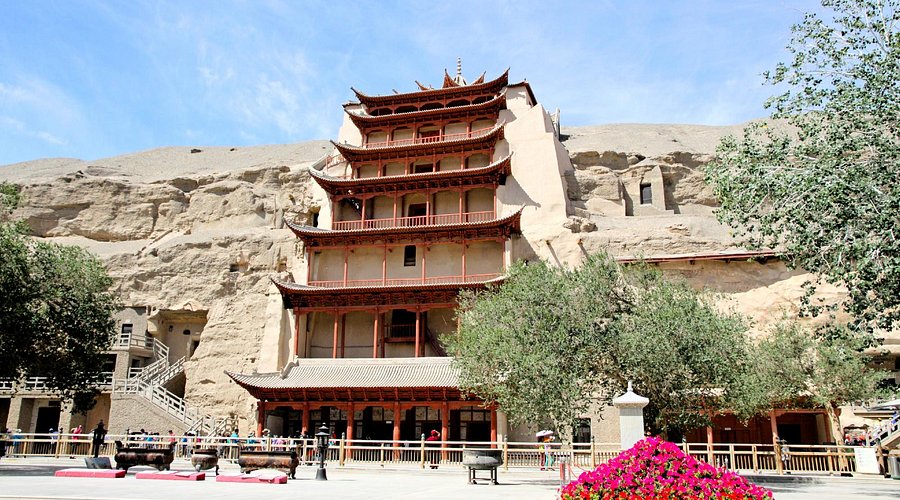
Mogao Caves.
Tickets: Prices, Booking, and Tips
When planning your visit to the iconic Mogao Caves, understanding the ticketing process and pricing can enhance your experience. Nestled in the Gobi Desert, these remarkable caves are a UNESCO World Heritage site, showcasing exquisite wall frescoes and over 3,000 sculptures that date back from the 4th to the 14th century.
Ticket Prices
Admission to the Mogao Caves is approximately 250 CNY (about $35 USD) per person. This ticket grants you access to the site and its accompanying digital exhibition center, where you’ll begin your journey through the caves. Keep in mind that prices may vary slightly depending on the season or any special exhibitions that may be ongoing.
Booking Tickets
It is highly recommended to purchase your tickets in advance, especially during peak tourist seasons. You can book tickets through various platforms, with Trip.com being a reliable option for international travelers. Reservations can often be made online, ensuring you secure your spot without the hassle of long queues upon arrival.
Guided Tours
Most visitors benefit from joining a guided tour, which provides deeper insights into the history and artistry of the caves. The tours typically start with a 3D audiovisual presentation at the visitor center, followed by a guided exploration of the caves. During the tour, only a limited number of caves are accessible, so be prepared to make the most of your time by focusing on these highlights.
Tips for a Smooth Visit
- Arrive Early: Aim to arrive when the site opens at 9:00 AM to avoid the crowds and enjoy a more personal experience.
- Language Assistance: If you are a non-Chinese speaker, inform the staff upon arrival, and they can arrange for an English-speaking guide. Japanese audio guides are also available.
- Stay Hydrated: Bring water and snacks, as food and drink are not sold in the cave area. You can eat on the benches provided.
- Plan for Time: Allocate 2-3 hours for your visit to fully appreciate the caves and the exhibits. If possible, consider attending multiple performances or tours on different days to gain a comprehensive understanding of the site.
- Respect the Site: As a UNESCO World Heritage site, it’s essential to follow all guidelines and regulations to help preserve the caves for future generations.
By following these tips and understanding the ticketing process, your visit to the Mogao Caves will be both enjoyable and informative, leaving you with unforgettable memories of this historic treasure.
How to Get There: A Complete Transportation Guide
Reaching the iconic Mogao Caves, a UNESCO World Heritage site located near Dunhuang, is an adventure that combines scenic views with a glimpse into China’s rich history. Here’s your comprehensive guide to navigating the journey to this breathtaking destination.
Getting to Dunhuang
By Air:
The most convenient way to reach Dunhuang is by flying into Dunhuang Airport (DNH). The airport has domestic flights connecting to major cities like Beijing, Xi’an, and Lanzhou. Once you land, you can take a taxi or pre-arranged transfer directly to your hotel or the Mogao Caves visitor center.
By Train:
For those who prefer a scenic train journey, Dunhuang is accessible via the Lanzhou-Dunhuang Railway. The train ride offers stunning views of the Gobi Desert and typically takes about 12 hours from Lanzhou. Upon arrival at Dunhuang Railway Station, you can take a taxi or local bus to the Mogao Caves, which is approximately 25 kilometers away.
By Bus:
Long-distance buses operate from several cities in China, including Xi’an, Zhangye, and Jiayuguan. The bus journey can be a more economical option but may take longer than flying or taking the train. The main bus station in Dunhuang is well-connected to local transportation options.
Local Transportation to Mogao Caves
Visitor Center:
When you arrive in Dunhuang and plan to visit the Mogao Caves, your first stop should be the Mogao Caves Digital Exhibition Center, where you can purchase tickets and enjoy an informative multimedia presentation about the caves. The center is approximately 5 kilometers from the city center.
Shuttle Bus:
After your visit to the Digital Exhibition Center, you will board a shuttle bus that takes you directly to the Mogao Caves. The bus ride is included in your ticket price and typically runs every 20-30 minutes. It’s advisable to arrive early, as there are timed entry slots for the caves.
Taxi Services:
If you prefer more direct transportation, taxis are readily available in Dunhuang. A taxi ride from the city center to the Mogao Caves takes about 30 minutes. Ensure that the driver knows your destination, as English may not be widely spoken.
Tips for a Smooth Journey
-
Book in Advance: Given the popularity of the Mogao Caves, it’s wise to book your tickets in advance, especially during peak tourist seasons. You can secure your tickets through reputable websites like Trip.com or directly at the visitor center.
-
Plan Your Visit: Allocate at least 2-3 hours for the caves themselves. The visit includes a guided tour of selected caves, and there may be restrictions on the number of caves you can access, so be sure to check the latest visitor guidelines.
-
Stay Hydrated and Snack Ready: Given the desert climate, carry water and some snacks, as food options are limited near the caves. You can take breaks in designated areas, but be mindful of the regulations regarding food and drink.
-
Explore Beyond the Caves: If time permits, consider visiting nearby attractions like the Crescent Moon Spring and the Singing Sand Dunes for a complete Dunhuang experience.
With this transportation guide, you’re well-equipped to embark on your journey to the magnificent Mogao Caves. Prepare for an unforgettable encounter with history, art, and the stunning landscapes of the Gobi Desert!
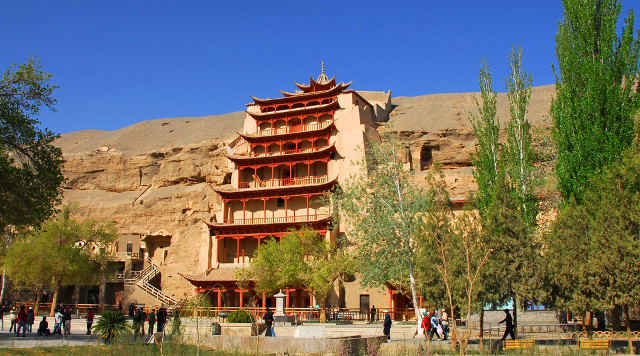
Mogao Caves.
Local Cuisine and Accommodation Nearby
When visiting the magnificent Mogao Caves, your experience can be further enriched by indulging in local cuisine and finding comfortable accommodations nearby. Dunhuang, with its unique blend of cultures along the ancient Silk Road, offers a delightful array of dining options and places to stay.
Local Cuisine
1. Dunhuang Night Market (沙洲夜市)
A visit to Dunhuang would be incomplete without experiencing its vibrant night market. Here, you can savor a variety of local delicacies, including the famous Dunhuang lamb skewers and hand-pulled noodles. Make sure to try the pomegranate juice—a refreshing local specialty that perfectly complements the flavors of the dishes.
2. Yangguan Restaurant (阳关酒店)
Located just a short drive from the Mogao Caves, this restaurant offers an extensive menu featuring traditional Chinese dishes with a local twist. The Dunhuang-style dumplings and sizzling beef are highly recommended. The restaurant’s warm atmosphere and friendly service make it a perfect spot for a hearty meal after a day of exploration.
3. Crescent Moon Spring Café
If you find yourself near Crescent Moon Spring, take a break at the nearby café. They serve simple yet delicious snacks and drinks, including tea sets and local pastries. It’s a lovely spot to unwind and soak in the picturesque desert scenery.
Accommodation Options
1. Dunhuang Silk Road Hotel (敦煌丝绸之路大酒店)
A popular choice among travelers, this hotel combines comfort with convenience. Situated close to the Mogao Caves and other attractions, it offers modern amenities along with traditional décor. Guests can enjoy a complimentary breakfast featuring local dishes, ensuring a good start to your day of adventure.
2. Dunhuang International Hotel (敦煌国际大酒店)
For those seeking a more luxurious stay, the Dunhuang International Hotel provides elegant rooms and excellent services. The hotel features a rooftop restaurant with stunning views of the surrounding desert, where you can enjoy both Chinese and international cuisine.
3. Backpacker’s Hostel Dunhuang (敦煌背包客旅舍)
Ideal for budget travelers, this hostel offers a friendly atmosphere and is situated within walking distance of the night market. It provides basic amenities, communal areas, and a chance to meet fellow travelers. The hostel staff can also help arrange tours to the Mogao Caves and other local attractions.
Dunhuang is a treasure trove of culinary delights and cozy accommodations, making it the perfect base for exploring the awe-inspiring Mogao Caves. Whether you’re indulging in local flavors or relaxing in comfort after a day of discovery, this enchanting desert town has something for every traveler.
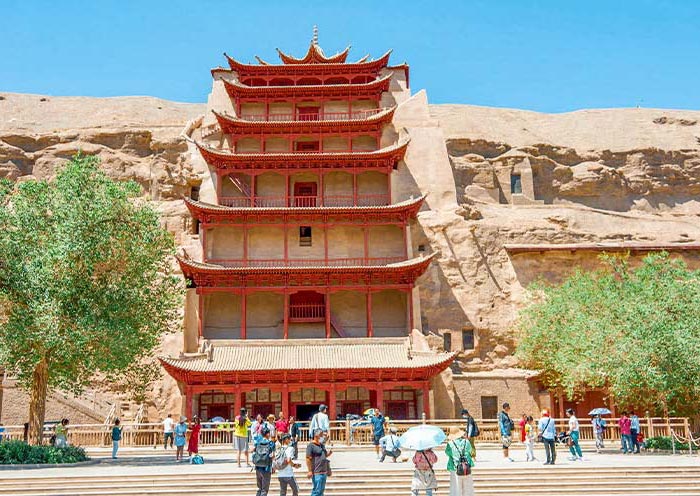
Mogao Caves.
Frequently Asked Questions
Frequently Asked Questions about the Mogao Caves
-
What are the Mogao Caves?
The Mogao Caves, also known as the Caves of the Thousand Buddhas, are a complex of Buddhist cave temples located in the Gobi Desert near Dunhuang, China. Dating from the 4th to the 14th centuries, they feature stunning wall frescoes and over 3,000 sculptures, making them a UNESCO World Heritage site. -
How do I get to the Mogao Caves?
The Mogao Caves are easily accessible from Dunhuang, which can be reached by train or flight from major cities in China. From Dunhuang, you can take a taxi or join a guided tour that typically includes transport to the caves. -
What are the opening hours?
The Mogao Caves are open daily from 9:00 AM to 5:00 PM. It’s advisable to check for any updates on hours or special closures before your visit. -
How much does it cost to enter the caves?
Admission to the Mogao Caves is approximately 250 yuan (around $35 USD), which typically includes access to a digital exhibition center and a guided tour through selected caves. Prices may vary, so it’s best to confirm before your visit. -
Is there a guided tour available?
Yes, guided tours are available and highly recommended to enhance your experience. English-speaking guides can provide valuable insights into the history and significance of the caves. It’s advisable to book a tour in advance, especially during peak tourist seasons. -
Can I take photos inside the caves?
Photography is generally prohibited inside the caves to protect the delicate artworks. However, you can take photos in designated areas such as the visitor center and surrounding landscapes. -
What should I wear and bring?
Dress comfortably and in layers, as temperatures can vary significantly. Good walking shoes are essential, as exploring the caves involves some walking. Additionally, bring water and snacks, as there are limited food options nearby. -
Are there facilities for international visitors?
Yes, the visitor center offers services in multiple languages, including English. If you inform the staff that you are an international visitor, they can provide headsets for audio guides and arrange for English-speaking tours.
Final Thoughts on Your Trip
As you prepare to leave the enchanting Mogao Caves, take a moment to reflect on the rich tapestry of history and artistry that this UNESCO World Heritage site has to offer. Nestled in the vast Gobi Desert, these ancient caves invite you to step back in time, revealing the spiritual and cultural significance of Buddhist art from the 4th to the 14th centuries.
The breathtaking frescoes and intricate sculptures are not merely relics of the past; they are a testament to the dedication and creativity of countless artisans who poured their hearts into these sacred spaces. As you walk through the cool, echoing chambers, let the stories of pilgrimage and devotion resonate within you.
Whether you marveled at the stunning visuals during the digital exhibition or found serenity amidst the quietude of the caves, your journey here is sure to leave an indelible mark on your soul. Don’t forget to capture the moment, share your experience, and inspire others to embark on their own adventure to this remarkable destination.
Visiting the Mogao Caves transcends mere sightseeing; it’s an invitation to connect with the ancient world and a reminder of the beauty that lies in cultural heritage. As you leave, carry with you not just memories, but a deeper appreciation for the artistry and spirituality that continue to thrive in this extraordinary corner of the Silk Road. Safe travels, and may your next adventure be just as transformative!